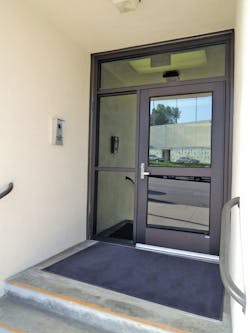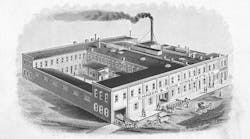How many times have you traveled to a customer’s facility to see and discuss the customer’s problem? Your customer knows exactly what he or she needs to solve that problem. The hard part sometimes occurs when you have to figure out what is the solution.
Finding the solution begins when your customer and you both understand what the customer wants. Sometimes the solution comes quickly and it is easy to determine the appropriate hardware. Other times, it becomes a matter of providing the customer with most of what he or she wants.
For this article, we will describe three entry scenarios. For each, we will explain what the customer wants and try to determine what available options are for controlling access. Each has a solution that satisfied the customer.
Each scenario will describe the entry (be it a door or gate),the customer’s problem and the possible components and any additional information. Once described, I will list the chosen solution. The customer has the final say, regarding the products, wiring requirements and installation considerations.
Important: Always discuss an installation involving electronic components with the local authority having jurisdiction (LAHJ) prior to purchasing or installing.
Scenario 1: Two Entry Doors
In our first scenario, the customer needs to control access to a mental health facility through two public entry doors. One faces the street, having several steps, and the second faces a public parking lot.
The building is shared with additional companies; however, the mental health center occupies one end of the structure. The employee parking lot and entry is in the rear of the building. Employees gain access by presenting their credentials.
The receptionist needs to control client access from his or her desk. However, the receptionist cannot see either entrance. To further complicate matters, the person who sits at the receptionist desk has multiple responsibilities and is not always at the desk. Therefore, a second person must provide backup. The backup person's desk does not have visual access to either entry door.
Both client entrances are recessed into the building. Each has a medium stile aluminum glass door and side light. The 4'0" wide doors are equipped with surface-mounted door closers. Sargent Rim Exit Devices are mounted onto the center rail. A surface-mounted electric strike is installed onto the jamb.
Being a mental health center makes matters somewhat more complicated. Doorbells are not used because they could disrupt therapy sessions, and at times access is only granted to specific individuals. Work hours vary by appointments and commitments.
To provide access, five customer requirements must be satisfied.
- Any person who requests access must be able to notify someone inside from the entry doors.
- Employees need "hands free" communication with the person who wants to gain access.
- Employees need to see and identify persons requesting access.
- Employees need the ability to record any person and conversation wishing to gain entry.
- Employees need to remotely provide access into the building.
An additional consideration was to protect the exterior access control components from weather and vandalism.
There were several choices for controlling access, such as a door buzzer, video recording system, intercom and remote release. This was not acceptable for several concerns. First, it would be difficult to use so many components. Second, there was no good place to mount cameras outside the entrances. Since both entries are recessed within the building, the camera would have to be mounted within arms’ reach of visitors, opening them up to possible vandalism.
A better solution was to install a telephone entry system that would satisfy all five considerations. After reviewing a number of such systems, the customer selected the Aiphone JF Series Hands-free Color Video Entry System. The hands-free, color video enhanced JF Series system will support up to two video door stations and up to three inside monitor stations. The video door station is vandal resistant, with a stainless steel faceplate, mounting box and metal call button. The camera lens is protected by a clear polycarbonate lens cover. With the built-in picture memory, the Aiphone JF Series system can record when a visitor calls in, automatically or manually.
Each Aiphone JF-DVF-HID Video Door Station features a color CCD camera, with built in speaker and microphone for communication. In low light conditions, the door station activates the built-in white LED illuminator for video. All monitor stations turn on when a video door station calls in.
An added benefit for employees is the embedded HID ProxPoint Plus proximity card Reader with a standard Wiegand output. The ProxPoint Plus can read HID cards with formats up to 85 bits.
The Aiphone JF-2MED Master Station and JF-2HD Sub Monitor Station have 3.5" TFT color LCD monitors, hands-free and press to talk communications. The JF-2MED has call, play record, menu/memo and monitoring buttons. It has picture memory, voice memo and message for entrance, and supports up to two additional inside stations.
The JF-2HD can be used to communicate with the door station and provide access. The JF-2HD and the JF-2MED stations have entrance monitoring, permitting viewing of the area around the door station.
To satisfy the needs of the center, the system includes two JF-DVF-HID Video Door Stations with embedded card readers, a JF-2MED Master Station and a JF-2HD Sub Monitor Station. An 18VDC power supply powers the two door stations and the master and sub monitoring stations. One power supply powers both electric strikes.
Wiring runs from the video door station to the farthest JF-2HD or JF-2MED should be no greater than 165 feetusing 22AWG or 330 feet using 18AWG. Aiphone mid cap, solid, non-shielded wire was used for this installation.
For more information on Aiphone products, contact your local locksmith distributor or Aiphone, phone 800-692-0200, website www.aiphone.com.
Scenario 2: Subway Tunnel Doors
In our second scenario, a large transportation authority was having problems with the doors leading into the subway tunnels. As a result of air being displaced by the trains, the mortise locks securing the access doors into the tunnels were failing in the locked condition. This problem was not occurring to all of the locks all of the time; sporadic occurrences resulted in affecting different tasks for the locksmiths and occasionally locking out other workers.
One of the problems seemed to revolve around the mortise lock case covers unscrewing, causing internal parts to disengage and disabling the lock in the locked condition. Different fixes were tried including adding thread adhesive and different mortise lock bodies.
A decision was made to replace the mortise locks with Sargent T-Zone cylindrical locks. The 11G04 locks were installed into the non-fire rated doors using a Don-Jo Remodeler Plate Kit, part number RPK-109-630. Note: the screws included with the remodeler kits designed to be installed onto the door surface were not meaty enough. Large tech screws do a better job.
Important: On Fire Assemblies, this would violate the rating as the door was prepped for mortise locks and remodeler kits are not approved for this use.
For more information on Sargent products, contact your local locksmith distributor or Sargent, an ASSA ABLOY Group company, telephone 800-727-5477, website www.sargentlock.com.
Scenario 3: Gate
Our third scenario involves a large facility of multiple buildings covering many acres. One of the buildings has an attached covered area of a few thousand square feet that houses occasionally used machinery and provides temporary storage for packaging and other materials. This fenced-in elevated concrete area is about three feet above ground level within a semi-remote location, being at the rear of several buildings.
The covered area has two entrances: an entry door with restricted electronic access from the interior of the adjacent building and a large sliding gate that was previously equipped with a chain and padlock. The gate, constructed of welded steel, is approximately six feet tall by about 10 feet long, running along one edge of the elevated concrete. The gate is part of a tall fence wall that is above and at the rear of the gate. The gate is mainly used for delivery and picking up materials and equipment. It can be accessed 24 hours a day, seven days a week.
For many years, security meant a chain and padlock. Each authorized used carried a mechanical key. Key control difficulties resulted when outside vendors lost or misplaced keys. These missing keys became a security risk and a better method for controlling access had to be implemented.
The decision was made to upgrade to electronic access control, consisting of a gate lock, card reader, push-to-exit button and power supply. The customer chose to provide the vendors with temporary identification badges that could have a set expiration date. In case the badge was lost or the vendor did not return it, the badge could be immediately deleted from the system, eliminating the "key" aspect of unauthorized access.
A Securitron GL1 Gate Lock designed for sliding gates was selected. The surface-mounted GL1 has 2000 pounds holding force. This Fail Secure 12/24VDC lock peak current draw is 870mA (12VDC) and 720mA (24VDC).
According to Securitron, it can operate with a pre-load of up to 100 pounds. The lock receiver is self aligning +/- ½" horizontally. The housing is tamperproof cast aluminum. Two cam locks secure the cover to the lock chassis. The hardened steel latch is spring loaded to swing up and down.
The lock is heavy duty, sufficient to withstand someone sliding the gate rapidly or sliding the strike assembly at full force without any damage resulting.
To complete the installation, a push-to-exit button, card reader and one Amp power supply were installed. The GL1 comes with the Securitron MagnaCare Lifetime Replacement Warranty.
For more information on products from Securitron Magnalock Corp., an ASSA ABLOY Group company, contact your local locksmith distributor or Securitron, phone 800-624-5625. Website: www.securitron.com.






